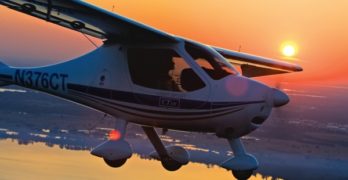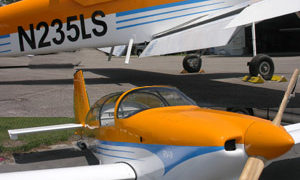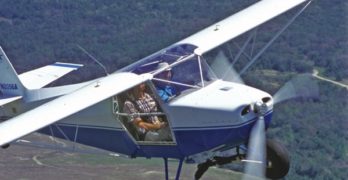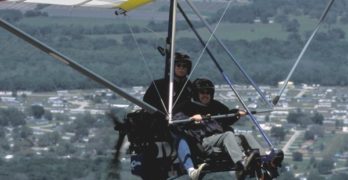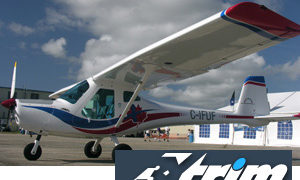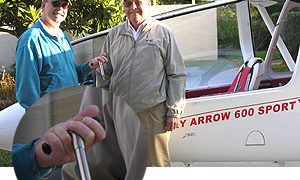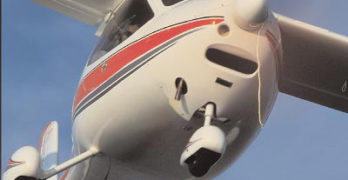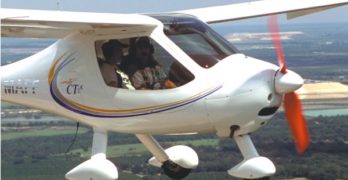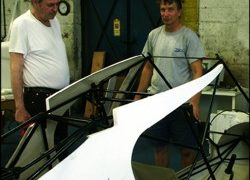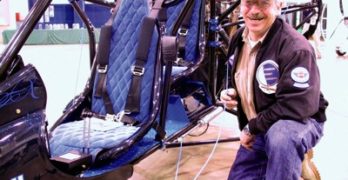In the 15 months since the first two special light-sport aircraft (S-LSA) were introduced
at the Sun ‘n Fun Fly-In in Lakeland, Florida, a wave of S-LSA have taken to the
sky. The number delivered to customers is approaching 500 aircraft — and climbing as
quickly as factories can produce and deliver them. The years ahead should see a sharply
increasing number of LSA flying in America.
The good news for pilots is we won’t
just have more LSA, we’ll have better
ones as designers modify and improve
aircraft based on customer input and
service history. That’s one of the benefi
ts of consensus standards versus
type certification-manufacturers
can cram more features into the airplanes
and factories may refine production
techniques without undergoing
costly recertification. The best
news is we don’t have to wait. “New
and improved” LSA are here now.
The 2006 CT
Because of its distinctive profile, the
Flight Design CT is one of the most
recognized S-LSA flying.
Search Results for : CT AND hand control
Not finding exactly what you expected? Try our advanced search option.
Select a manufacturer to go straight to all our content about that manufacturer.
Select an aircraft model to go straight to all our content about that model.
Jay Kurtz and His RV-9 ELSA!
Jay Kurtz is the owner of South Lakeland airport (X49), where vendors often conduct customer demonstration flights a mere four miles away from Sun ‘n Fun. A longtime participant in ultralight aviation, Jay’s built RANS models, Capella designs, and a “regular” RV-9A. But it’s his second RV-9 that really has him revved up; this one is can be flown by a Sport Pilot! Not possible? Too fast and too heavy? Wrong! Jay’s RV-9 ELSA weighs 906 pounds empty and is headed to 875 pounds with planned weight savings. Powered by a 108-hp Lycoming O-235, speed is prop controlled to reach 134 mph at max continuous power. *** With the required 10 hours now flown off Jay can use the ELSA like any other Light-Sport Aircraft. And he reports the weight reductions to stay under 1,320 pounds gross transformed the ‘9 ELSA. “I approach at 60 mph, 20 slower than the RV-9A!” Jay also raved about handling and slow speed flight characteristics.
Just Aircraft’s Highlander
If you’re familiar with Avid Flyer or Kitfox aircraft, you know at least something about Just Aircraft’s Highlander. Its pedigree “path” is somewhat meandering but leads to an excellent flying machine born of a rich American airplane design heritage.
Dean Wilson was the originator of this now-proven design shape. The first departure from Wilson’s Avid Aircraft company was Dan Denney, who went on to offer the Kitfox. Denney’s prowess as a marketer brought international fame to the Kitfox and, over the years, the sale of nearly 3,000 aircraft. At one time Denney Aerocraft was among the country’s largest suppliers of kit-built aircraft. What had been an ultralight design evolved into a successful 2-seat homebuilt, but that wasn’t the end of the evolution behind Wilson’s original creation. Denney sold his company to Phil Reid, who renamed the Idaho company SkyStar.
A Well-Evolved History
Another break-off from Avid Aircraft and Denney Aerocraft was Flying K Enterprises, which introduced the single-seat Sky Raider.
TC’s Trikes and North Wing Team Up on Coyote
Two years ago, I flew and reported on the only model TC’s Trikes offered. Though their line had little depth, the Tennessee company built their own wing and chassis. Many trike chassis builders purchase wings from other sources, much like happens universally in powered parachutes. TC’s Trikes did it all based particularly on their needs as an active flight school operation.
In today’s light aircraft world, a wider product line addresses more pilots, which makes a more viable business. Given the pace of refinements, it can be tough to keep up. Yet TC’s Trikes had a track record in the East, selling more than 100 trikes of their own and other brands. Pairing up with another company, if the fit was right, could be smart business.
A match was found between TC’s Trikes and Washington state-based North Wing Design. TC’s Trikes had something North Wing lacked – a presence in the Eastern USA.
Delightful-to-Fly Light-Sport Aircraft from Poland
Much attention on LSA seems to focus on U.S.-built aircraft or those from Czech Republic. Of course we have many other countries contributing to the growing U.S. fleet including Germany, Italy, and Australia. While Poland also contributes fabrication to the German-designed FK Lightplane series, the country isn’t widely known to Americans as an LSA provider. Its fuselage boom with vertical flanges (assembled from two fuselage halves) shows how this airplane descends from sailplane gliders built for many years in Eastern Europe. Imported by Rainbow Sport Aviation in Canada, the creator of the 3X55 is Adam Kurbiel, who designed gliders at the SZD-PZL glider factory before turning his attention to light airplanes. A modest cruiser (88 knots or 101 mph at 75% power), 3X55 handles beautifully and lands easily. The 47-inch-wide interior is nicely appointed with modern controls to match more expensive aircraft. Priced at $73,500 with the 80-hp Rotax, 3X55 seems a relative bargain.
Flying a Hand Control Sky Arrow at Spruce Creek
Maybe you’ve heard about Able Flight, an organization formed to assist people with disabilities to fly. This worthy effort recently awarded its first two scholarships with more to come. Sponsors are lining up and this summer will see a special presentation at AirVenture Oshkosh. The aircraft of Able Flight’s focus is the Sky Arrow which offers special hardware allowing the SLSA to be flown via hand controls. *** I had the chance to fly the Sky Arrow with Jon Hansen of Hansen Air Group, the eastern rep for Sky Arrow USA. We flew at Spruce Creek (near Daytona, Florida), which bills itself as the “World’s Finest Residential Airpark” and must also be one of the largest with some 500 homes that offer nearby parking for airplanes or an attached hangar. *** Flying Sky Arrow with the hand controls was different but highly effective.
Flight Design CT2K
A Bold Yet Efficient Euro-Designed Light-Sport Aircraft
Flightstar imports the CT2K in anticipation of the light-sport aircraft rule.
As FAA’s proposed light-sport aircraft
rule looms ever closer, one
of the first aircraft that will likely
fit the field and be recognized by American
pilots is Germany’s CT. For the U.S.
market, and with a nod to the new millennium,
producer Flight Designs has
renamed the model as the CT2K.
“CT” stands for Composite Twoseater.
It is certainly not alone in being
“white, glass, and built overseas,” a
theme that emerged at EAA AirVenture
Oshkosh 2002. But the design was a
leader in the move from tube-and-rag
ultralights to the modern microlights of
Europe. And it distinguishes itself in a
number of ways that we’ll explore in
this review.
My experiences flying the CT on two
occasions were both with Europeanbased
check pilots. The most recent
opportunity was with Allistair Wilson,
formerly a major with the Royal Irish
Regiment in Northern Ireland.
Composite Two-seater (CT)
In the fall of ’01, I wrote in Ultralight Flying!, “The CT is the tip of an iceberg, in my opinion.” When I flew that first CT in the USA, few Yankees had seen the aircraft. I felt the German design represented the beginning of a flow of European aircraft coming to America. What a difference a couple of years make!
Thanks to adept and steady promotion, Americans may best identify the coming breed of proposed Light-Sport Aircraft by pointing to the Flight Design CT2K. While this means no disrespect to trikes, tube-and-rag ultralights, or powered parachutes, the CT’s unusual, smoothly-contoured shape is now well known to many Americans. Though the brand is fabricated in the Ukraine and assembled in Germany, it crosses the Atlantic as a prototypical candidate for FAA’s proposed Light-Sport Aircraft category.
Rollison Light Sport Aircraft imported the first U.S.-based CT I flew. The design is now brought in by Flightstar Sportplanes and HPower HKS engine honcho Tom Peghiny.
Manufacturing Earthstar Aircraft in Israel
Avicom, Earthstar’s new partner in building Odysseys and Gull 2000s, has been
an importer and distributor of American-made aircraft in Israel for several years,
but taking on the manufacturing of an aircraft is a different enterprise. Still,
Avicom principles Miki “Mike” Raviv and Abraham “Kim” Kimchi understood that
Mark’s designs needed and deserved better manufacturing capability. They will
accomplish that goal through a partnership with Kanfit Ltd., a well-established
aerospace parts and systems manufacturer in Israel.
In May 2005, Mark and his wife,
Leslie, visited Israel to evaluate Avicom
and Kanfit. After a week of visits and
meetings, the American couple took
home a Technology Transfer Agreement
for review.
On July 18, 2005, the contracts were
signed, giving Avicom the manufacturing
and worldwide marketing rights to
the Odyssey and Gull 2000.
In late July, Mike and Kim flew with
Mark from Earthstar’s headquarters
in Santa Margarita, California, to EAA
AirVenture Oshkosh 2005 to become better
acquainted with the aircraft and the
business.
Hand Control PPC
One innovative designer offers an alternative to foot-controlled powered parachute flight.
For those of you that don’t know, most powered parachutes are steered around the sky using your legs. Pushing with your right leg exerts downward force on a steering line routed to the right trailing edge of the canopy/wing, producing drag on that side and initiating a turn in that direction.
The motion isn’t hard-though some designers have added mechanical advantage to make it easier-and the turn is more responsive that you might imagine. But what if you don’t have good use of your legs? How might you fly a powered parachute?
Canadian powered parachute manufacturer Para-Ski offers a handlebar arrangement, and other companies have experimented with similar ideas. But nearly every other supplier of these flying machines uses a foot-steering arrangement of one kind or another. James Leon of Kankakee, Illinois, has another alternative.
Call It Power Steering
While Para-Ski has its handlebars, a measure of physical effort is still involved.
- « Previous Page
- 1
- …
- 9
- 10
- 11
- 12
- 13
- …
- 62
- Next Page »


